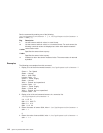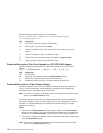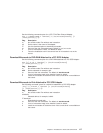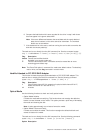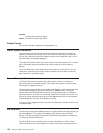
Download Microcode to Other Devices
See the following command syntax:
diag -c -d
device_name
-T "download [-s diskette] [-l previous] [-F]"
Flag Description
-F Force the download microcode even if the current level is unavailable on the
source.
-l Microcode level. Latest is default.
-s Source of the new microcode. The default is /etc/microcode. Default source
device is disk.
Fault Indicators
Note: Prior to Diagnostics version 5.1.0.35, this task was also known as the System
Fault Indicator task.
This task is used to display or reset the Fault Indicators on the systems that support
this function. This task may also be used to set the Fault Indicators for testing
purposes, but the Indicators are not set back to normal when you exit this task.
The Fault Indicators are used to identify a fault with the system. These indicators may
be set automatically by hardware, firmware, or diagnostics when a fault is detected in
the system.
The Fault Indicators are turned off when a Log Repair Action is performed. After a
serviceable event is complete, do a System Verification to verify the fix. Also do a Log
Repair Action if the test on the resource was good, and that resource had an entry in
the error log. If the serviceable event was not a result of an error log entry, use the Log
Repair Action Task to turn off the system fault indicator.
For additional information concerning the use of these indicators, refer to the system
guide.
Note: The AIX command does not allow you to set the fault indicators to the Fault
state.
Use the following command syntax:
/usr/lpp/diagnostics/bin/usysfault [-s normal] [-l location code]
Flag Description
-s
normal
Sets the Fault Indicator to the normal state.
-l
location code
Identifies the resource by physical location code.
When the command is used without the -s flag, the current state of the indicator is
displayed as normal or attention.
When teh command is used without the -l flag, the Primary Enclosure resource is used.
118 Eserver pSeries 690 User’s Guide







